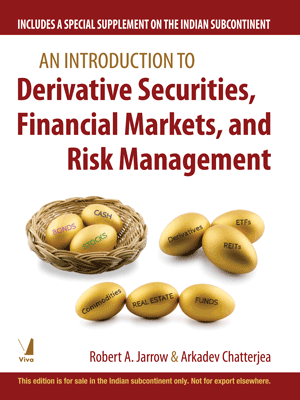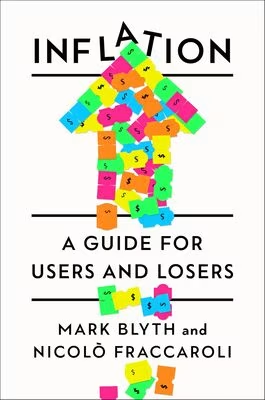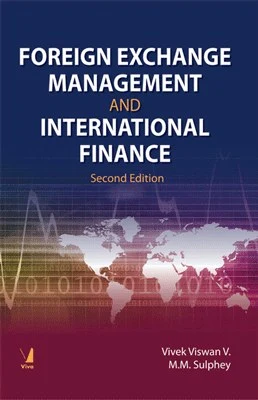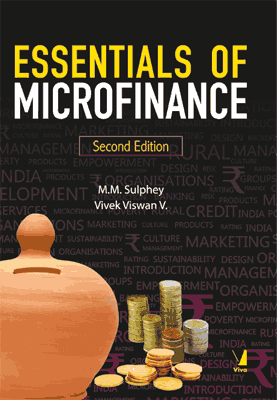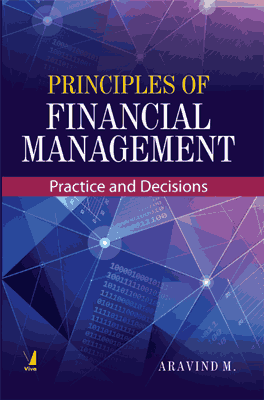An Introduction to Derivative Securities, Financial Markets, and Risk Management
An Introduction to Derivative Securities, Financial Markets, and Risk Management
Includes a Special Supplement on the Indian Subcontinent
₹1,165.50 ₹1,295.00 Save: ₹129.50 (10%)
Go to cartISBN: 9788130923390
Bind: Paperback
Year: 2016
Pages: 880
Size: 7.25 x 9.5 Inch
Publisher: W. W. Norton & Company
Published in India by: Viva Books
Exclusive Distributors: Viva Books
Sales Territory: India, Nepal, Pakistan, Bangladesh, Sri Lanka
"The Jarrow Chatterjea chapters are far more intuitive and with more insightful examples than the text I am currently using. That is fantastic"
"Two features that I find appealing, and which I believe are unique here, are the extensive coverage of interest-rate derivatives and market-microstructurelinstitutional trading details."
-Farid Aitsahlia, University of Florida
"The Jarrow Chatterjea text goes beyond the financial product description and discusses some practical applications of the product."
-Joel Vanden, Penn State University
Description:
"In today's complex world, modern financial institutions cannot succeed without the use of derivatives for managing the varied risks of their assets and liabilities.This book was written to be the first book read on derivatives, and not the last. Our aim has been to design a book that is closely connected to real markets, examines the uses of derivatives but warns against their abuses, and presents only the necessary quantitative material in an "easily digestible form" (and no more!)."
We do not know why futures markets did not independently develop in South Asia. Futures traded in British India, but the markets were small. As derivative trades are fundamental economic transactions, other derivatives markets certainly existed.They got traded in informal, over-the-counter markets. We find several ?patterns? in the growth of derivatives markets and regulations in the lndian subcontinent when compared with those in other parts of the world.
Also Available
Solutions Manual for An Introduction to Derivative Securities, Financial Markets, and Risk Management by the authors of the text, Robert A. Jarrow and Arkadev Chatterjea.
The manual includes detailed solutions to all 500+ end-of-chapter questions and problems.
PRICED!
This text is accompanied by an easy to use spreadsheet program called PRICED!, which computes the four basic models in the book: the binomial, the Black-Scholes-Merton, the discrete time Heath-Jarrow-Morton, and the continuous time Heath-Jarrow-Morton Libor.
Target Audience:
Students and Academicians of Finance, Investment Studies, Financial Markets, Risk Management etc.
Contents:
Preface
Part 1: Introduction
Chapter 1 Derivatives and Risk Management
Introduction • Financial Innovation: Expanding Derivatives Markets • Two Economic Motives • Traded Derivative Securities • EXTENSION 1.1 The Influence of Regulations, Taxes, and Transaction Costs on Financial Innovation • Diverse Views on Derivatives • Applications and Uses of Derivatives • A Quest for Better Models • Defining, Measuring, and Managing Risk • The Regulator's Classification of Risk • Portfolio Risk Management • Corporate Financial Risk Management: Risks That Businesses Face • Nonhedged Risks • Risk Management in a Blue Chip Company • Risk Management Perspectives in This Book • Summary • Cases • Questions and Problems
Chapter 2 Interest Rates
Introduction • Rate of Return • Basic Interest Rates: Simple, Compound, and Continuously Compounded • EXTENSION 2.1 Conventions and Rules for Rounding, Reporting Numbers, and Measuring Time • Discounting (PV) and Compounding (FV): Moving Money across Time • EXTENSION 2.2 Moving Multiple Cash Flows across Time • US Treasury Securities • US Federal Debt Auction Markets • EXTENSION 2.3 Discriminatory Auctions versus Uniform Price Auctions: Different Ways of Investing in Treasury Securities • The Treasury Auction and Its Associated Markets • The Repo and the Reverse Repo Market • EXTENSION 2.4 A Repurchase Agreement: Interest Rate Derivatives • Treasury Bills, Notes, Bonds, and STRIPS • Libor versus Bbalibor • Summary • Cases • Questions and Problems
Chapter 3 Stocks
Introduction • Primary and Secondary Markets, Exchanges, and Over-the-Counter Markets • Brokers, Dealers, and Traders in Securities Markets • EXTENSION 3.1 The Market Microstructure of Securities Markets • Automation of Trading • The Three-Step Process of Transacting Exchange-Traded Securities • Buying and Selling Stocks: Trading at the New York Stock Exchange • EXTENSION 3.2 Back-Office Operations in the New Millennium • Over-the-Counter Trading • Alternative Trading Systems: Dark Pools and Electronic Communications Networks • Dollar Dividends and Dividend Yields • Short Selling Stocks • Margin: Security Deposits That Facilitate Trading • EXTENSION 3.3 Margin and Stock Trading • Summary • Cases • Questions and Problems
Chapter 4 Forwards and Futures
Introduction • Forward Contracts • The Over-the-Counter Market for Trading Forwards • Futures Contracts • Exchange Trading of a Futures Contract • EXTENSION 4.1 Forward and Futures Prices: The Same or Different? • EXTENSION 4.2 Futures Exchanges in China, India, and Ethiopia, and E-Choupal in Village Index • Hedging with Forwards and Futures • Summary • Cases • Questions and Problems
Chapter 5 Options
Introduction • Options • Call Options: Call Payoffs and Profit Diagrams • The Call's Intrinsic and Time Values • Price Bounds for American Calls • Put Options: Put Payoffs and Profit Diagrams • The Put's Intrinsic and Time Values • Price Bounds for American Puts • Exchange-Traded Options • EXTENSION 5.1 Benefits of Exchange-Traded Options • Longs and Shorts in Different Markets • Order Placement Strategies • EXTENSION 5.2 More Order Placement Strategies • Summary • Cases • Questions and Problems
Chapter 6 Arbitrage and Trading
Introduction • The Concept of Arbitrage • The No-Arbitrage Principle for Derivative Pricing: The Law of One Price • Nothing Comes from Nothing • Efficient Markets • EXTENSION 6.1 The Efficient Markets Hypothesis • In Pursuit of Arbitrage Opportunities: The Closed-End Fund Puzzle • Spread Trading • Index Arbitrage • EXTENSION 6.2 Stock Indexes: Algos • Hedge Funds • EXTENSION 6.3 Index Arbitrage • EXTENSION 6.4 Hedge Fund Investment Strategies • Illegal Arbitrage Opportunities: Floor Trading Abuses • Market Manipulation • Summary • Cases • Questions and Problems
Chapter 7 Financial Engineering and Swaps
Introduction • The Build and Break Approach • Financial Engineering: Cash Flows versus Asset Values • Examples • An Introduction to Swaps • Applications and Uses of Swaps • Types of Swaps: Interest Rate Swaps • Forex Swaps • Currency Swaps • EXTENSION 7.1 Valuing Fixed-for-Fixed Currency Swaps: Commodity and Equity Swaps • Credit Default Swaps • Summary • Cases • Questions and Problems
Part 2: Forwards and Futures
Chapter 8 Forwards and Futures Markets
Introduction • Applications and Uses of Forwards and Futures • A Brief History of Forwards and Futures: Early Trading of Forward and Futures-Type Contracts • US Futures Exchanges and the Evolution of the Modern Futures Contract, 1848-1926 • Recent Developments, 1970 Onward • Futures Contract Features and Price Quotes: Commodity and Financial Futures Contracts • The Gold Futures Contract • Gold Futures Price Quotes • The Exchange and Clearinghouse • Commodity Price Indexes • EXTENSION 8.1 Doomsters and Boomsters • Summary • Cases • Questions and Problems
Chapter 9 Futures Trading
Introduction • Brokers, Dealers, and the Futures Industry • Floor Trading of Futures Contracts • Entering and Ending a Futures Position • Margin Accounts and Daily Settlement: Daily Settlement • Futures and Forward Price Relations: Equality of Futures and Spot Price at Maturity • Equality of Forward and Futures Prices before Maturity • Convergence of the Basis • Trading Spreads • Summary • Cases • Questions and Problems
Chapter 10 Futures Regulations
Introduction • Which Markets Have Futures? • Price Discovery • EXTENSION 10.1 Pentagon's Plan for a Futures Market on Terrorism • Hedging • Speculation • EXTENSION 10.2 When Sellers Have Market Power???A Tale of Two Cartels • Regulation of US Futures Markets • Major Regulatory Acts • The CFTC, the NFA , and the Regulatory Role of Exchanges • Enforcement Actions by the CFTC and the NFA • Manipulation in Futures Markets: Great Western Food Distributors and Egg Futures • How Onion Futures Got Banned • The Hunts Silver Case • Salomon Brothers and US Treasury Securities • Buying Cheese to Manipulate Milk Futures • Banging the Close • Managing Commodity Markets • Summary • Cases • Questions and Problems
Chapter 11 The Cost-of-Carry Model
Introduction • A Cost-of-Carry Example • The Assumptions • The Cost-of-Carry Model: The Model Setup • Using the Law of One Price • EXTENSION 11.1 A Formal Derivation of the Cost-of-Carry Model: Different Methods for Computing Interest • The Arbitrage Table Approach • Valuing a Forward Contract at Intermediate Dates • Linking Forward Prices of Different Maturities • Summary • Cases • Questions and Problems
Chapter 12 The Extended Cost-of-Carry Model
Introduction • A Family of Forward Pricing Models • Forwards on Dividend-Paying Stocks: The Cost-of-Carry Model with Dollar Dividends • EXTENSION 12.1 Dividend Policy: The Cost-of-Carry Model with a Dividend Yield • EXTENSION 12.2 Index Mutual Funds and Exchange-Traded Funds —Can a Monkey Do It-: A Synthetic Index • The Foreign Currency Forward Price • Extended Cost-of-Carry Models • Backwardation, Contango, Normal Backwardation, and Normal Contango • Market Imperfections • Summary • Cases • Questions and Problems
Chapter 13 Futures Hedging
Introduction • To Hedge or Not to Hedge: Should the Firm or the Individual Hedge? • The Costs and Benefits of Corporate Hedging • EXTENSION 13.1 Airlines and Fuel Price Risk • EXTENSION 13.2 A Hedged Firm Capturing a Tax Loss • Hedging with Futures: Perfect and Imperfect Hedges • Basis Risk • Guidelines for Futures Hedging • R isk-Minimization Hedging: The Mean-Variance Approach • Limitations of Risk-Minimization Hedging • Futures versus Forward Hedging • Spreadsheet Applications: Computing h • Summary • Appendix: Deriving the Minimum-Variance Hedge Ratio (h) • Computing the Minimum-Variance Hedge Ratio (h) • Statistical Approach • Econometric Approach: A Linear Regression Model • Cases • Questions and Problems
Part3: Options
Chapter 14 Options Markets and Trading
Introduction • Exchange-Traded Options • A History of Options: Early Trading of Options • EXTENSION 14.1 Derivatives Trading in the Netherlands (1550?1700) • EXTENSION 14.2 Russell Sage: The Old Straddle: The Year 1973: The Watershed Year and After • EXTENSION 14.3 Options on Futures • Option Contract Features: Maturity Dates • Strike Prices • Margin Requirements and Position Limits • Dividends and Stock Splits • Options Trading, Exercising, and the Expiration Process: The Trading Process • Exercising the Option • The Expiration Process • Options Price Quotes • Regulation and Manipulation in Options Markets • Summary • Cases • Questions and Problems
Chapter 15 Option Trading Strategies
Introduction • Traders in Options Markets • Profit Diagrams • The Nitty-Gritty Details of Options Trading • Options Strategies: Common Options Price Data • Naked Trades: The Basic Building Blocks • Hedged Strategies • Spread Strategies • EXTENSION 15.1 Collars, Ratio Spreads, Butterflies, and Condors • EXTENSION 15.2 Reinsurance Contracts and Call Spreads • Combination Strategies • EXTENSION 15.3 Taxation of Options Trades and Summaries of FASB 133 and 161 • Summary • Cases • Questions and Problems
Chapter 16 Option Relations
Introduction • A Graphical Approach to Put-Call Parity • Put-Call Parity for European Options • Market Imperfections • EXTENSION 16.1 Put?Call Parity in Imperfect Markets • EXTENSION 16.2 Dividends and American Options • Options Price Restrictions • EXTENSION 16.3 The Superglue Argument • Early Exercise of American Options: No Dividends • Dividends and Early Exercise • EXTENSION 16.4 Studies of Put?Call Parity, Price Bounds, and Early Exercise • Summary • Cases • Questions and Problems
Chapter 17 Single-Period Binomial Model
Introduction • Applications and Uses of the Binomial Model • A Brief History of Options Pricing Models: Option Pricing Pre-1973 • Option Pricing, 1973 and After • An Example: A Binomial Lattice • A Single-Period Example • The Assumptions • The Single-Period Model: The No-Arbitrage Principle • Building Binomial Trees • Arbitrage-Free Trees • Stock Prices and Martingales • The Pricing Model • The Hedge Ratio • Risk-Neutral Valuation • Actual versus Pseudo-probabilities • Robert Merton's “Trick” • Summary • Appendix: Proving the No-Arbitrage Argument • The Probabilities and Risk Premium • Cases • Questions and Problems
Chapter 18 Multiperiod Binomial Model
Introduction • Toward a Multiperiod Binomial Option Pricing Model: The Stock Price Evolution • Binomial Option Price Data • The Stock Price Tree • A Two-Period Binomial Model: Backward Induction • Option Pricing via Synthetic Construction (Method 1) • Repeat, Repeat: Risk-Neutral Pricing (Method 2) • One-Step Valuation: Prelude to the Multiperiod Model (Method 3) • The Multiperiod Binomial Option Pricing Model • Binomial Coefficients and Pseudo-probabilities: Recasting the Two-Period Example in the Multiperiod Framework • The n-Period Binomial Option Pricing Model • EXTENSION 18.1 Linking the Binomial Model to the Black”Scholes”Merton Model • Extending the Binomial Model: Known Dividends • Valuing American • Spreadsheet Applications: A Two-Period Binomial Example • A Sixteen-Period Example • Summary • Cases • Questions and Problems
Chapter 19 The Black-Scholes-Merton Model
Introduction • Applications and Uses • Nobel Prize-Winning Works (1973) • The Assumptions • EXTENSION 19.1 Bubbles and Option Pricing • The Pricing and Hedging Argument • The Black-Scholes-Merton Formula • Understanding the Black-Scholes-Merton Model: Stock Prices and Martingales • Risk-Neutral Valuation • Actual versus Pseudo-probabilities • The Greeks: Interpreting the Greeks • Some Road Bumps Ahead • EXTENSION 19.2 Market Manipulation and Option Pricing • The Inputs: Observable Inputs • Volatility: The Elusive Input • Extending the Black-Scholes-Merton Model: Adjusting for Dividends • Foreign Currency Options • Valuing American Options • EXTENSION 19.3 Exotic Options • Summary • Appendix: Modeling the Stock Price Evolution • Continuously Compounded (Logarithmic) Return • Introducing Uncertainty • The Central Limit Theorem • First Derivation of the Black-Scholes-Merton Formula (as a Limit of the Binomial Model) • Second Derivation of the Black-Scholes-Merton Formula (Using Risk-Neutral Valuation) • The Probabilities and the Risk Premium • Proof of (24) • Cases • Questions and Problems
Chapter 20 Using the Black-Scholes-Merton Model
Introduction • A Brief History of Model Usage: The Early History • EXTENSION 20.1 London and New York Options Markets in the Nineteenth Century After 1973 • Hedging the Greeks: Delta Hedging • Gamma Hedging • Hedging a Portfolio of Options • Vega Hedging • EXTENSION 20.2 Stochastic Volatility Option Models • Calibration: Theoretical and Econometric Models • Using Calibration • Implied Volatilities • EXTENSION 20.3 VI X: The Fear Index • The Black-Scholes-Merton Model: A Postscript • Summary • Appendix: The Mathematics of Delta, Gamma, and Vega Hedging • A Third Derivation of the Black-Scholes-Merton Formula • Cases • Questions and Problems
PART 4 Interest Rate Derivatives
Chapter 21 Yields and Forward Rates
Introduction • EXTENSION 21.1 Home Ownership and Derivatives • Yields • Revisiting Zeros: Yields and the Yield Curve • EXTENSION 21.2 The Expectations Hypothesis • Spread Trading • The Traditional Approach: Duration • Modified Duration Hedging • Applications and Limitations • Forward Rates • The Definition • Understanding Forward Rates • Using Forward Rates • EXTENSION 21.3 Computing Forward Rates from Coupon Bond Prices • The Basic Interest Rate Derivatives Contracts: A Brief History • Forward Rate Agreements • Interest Rate Futures • EXTENSION 21.4 T reasury Futures • The Equivalence between Forward and FRA Rates • Summary • Cases • Questions and Problems
Chapter 22 Interest Rate Swaps
Introduction • A Brief History: The Introduction of Swap Contracts • From a Brokerage to a Dealership Market • EXTENSION 22.1 The First Swap Deal: ISDA and Standardization of Contracts • Institutional Features: Entering a Swap Contract • Documentation • Closing a Swap Position • Valuation • Interest Rate Swaps: A Postscript: Municipal Swaps • EXTENSION 22.2 Government Usage of Swaps: Legal and Ethical Issues • EXTENSION 22.3 Caveat Emptor versus Proper Disclosure: Variations of Interest Rate Swaps • Swaps and FRAs: Synthesizing Swaps with Eurodollars and FRAs • The Yield and Swap Curve • EXTENSION 22.4 Computing Forward Rates from Swap Rates • Summary • Cases • Questions and Problems
Chapter 23 Single-Period Binomial Heath-Jarrow-Morton Model
Introduction • The Basic Interest Rate Derivatives: Uses of Caps, Floors, and Collars • A Brief History of Interest Rate Derivatives Models • The Assumptions • The Single-Period Model: Arbitrage-Free Evolutions • Zero-Coupon Bond Prices and Martingales • Understanding the Equal Pseudo-probability Condition • Actual versus Pseudo-probabilities • Caplet Pricing • The Hedge Ratio (the Holy Grail) • Risk-Neutral Valuation • Valuing a Floorlet • Valuing Various Interest Rate Derivatives • Multiple Factors • Summary • Appendix: The Equal Pseudo-probability Condition • Proof of Caplet and Floorlet Parity • Cases • Questions and Problems
Chapter 24 Multiperiod Binomial HJM Model
Introduction • The Assumptions • The Two-Period Model: Arbitrage-Free Evolutions • Zero-Coupon Bond Prices and Martingales • Caplet Pricing • Floorlet Pricing • Valuing Various Interest Rate Derivatives • Multiple Factors • The Multiperiod Model • Forwards, Futures, and Swaptions: Forward Rate Agreements • Eurodollar Futures • Comparing Forward and Futures Rates • Swaptions • Summary • Appendix: Linking the Binomial HJM Model and the HJM Libor Model • Cases • Questions and Problems
Chapter 25 The Heath-Jarrow-Morton Libor Model
Introduction • Why Caplets? • A History of Caplet Pricing: Black's Model • The Heath?Jarrow?Morton Model • The HJM Libor Model • EXTENSION 25.1 Black's Model for Pricing Commodity Options and Caplets • The Assumptions • EXTENSION 25.2 Alleged Manipulation of Bbalibor during 2007?9 • Pricing Caplets: Caplet and Floorlet Pricing (CFP) Data • Caplet Pricing Model • The Inputs: Observable Inputs • The Average Forward Rate Volatility • Understanding the HJM Libor Model: Forward Rates and Martingales • Risk-Neutral Valuation • Actual versus Pseudo-Probabilities • Caps and Floors: Caps • Floorlets • Caplet?Floorlet Parity • Floors • Using the HJM Libor Model: The Greeks • Delta Hedging • Gamma Hedging • American Options, Futures, Swaptions, and Other Derivatives • Summary • Cases • Questions and Problems
Chapter 26 Risk Management Models
Introduction • A Framework for Financial Risk Management • Computing the Loss Distribution • Value-at-Risk and Scenario Analysis: Value-at-Risk • Scenario Analysis • EXTENSION 26.1 Risk Measures • The Four Risks: Market Risk • Credit Risk • Structural Models • EXTENSION 26.2 Real Options: Reduced-Form Models • EXTENSION 26.3 Credit Default Swaps: Liquidity Risk • Operational Risk • The Credit Crisis of 2007: Residential Housing Price Bubble • Agency Problems • Credit Rating Agencies • Credit Derivatives • The Housing Price Crash • Regulatory Reforms • The Future of Models and Traded Derivatives: Model Risk • Derivatives • Summary • Cases • Questions and Problems
Appendix A: Mathematics and Statistics
A.1 Exponents and Logarithms: Exponents • Logarithms • Continuous Compoundings
A.2 The Binomial Theorem
A.3 The Normal Distribution
A.4 A Taylor Series Expansion: Single Variable • Multiple Variables
Appendix B Spreadsheet Software
B.1 Starting the Software: Enabling Macros • Features • Inputs
B.2 Bin+BSM.Input
B.3 BSM: Inputs • Computing Greeks • Convergence of Binomial to BSM • Output Graphs • Implied Volatilities
B.4 Binomial: Inputs • Payoff Function/Instrument Type • The Matrix
B.5 Bin.Print
B.6 Bin.xxx.xxx
B.7 HJM Tree: Cleanup • Draw Tree • Building a Tree
B.8 HJM Options: Inputs • Valuation • Cleanup
B.9 HJM Fwd+Fut: Inputs • Valuation • Cleanup • Technical Considerations
B.10 Libor: Inputs • Computing Greeks • Output Graphs • Implied Volatilities • Convergence of Binomial to HJM
B.11 Configure: Randomly Generated Trees • Input-Generated Trees • Library-Loaded Trees • B.12 Technical Details
Glossary G-1 • References R -2 • Notation N -2 • Additional Sources and Websites A -2 • Books on Derivatives and Risk Management B-2 • Name-Index NI -1 • Subject-Index SI -1 • A Special Supplement on Indian Subcontinent SS-1 • Errata (Editorial and Typos) E-1
About the Authors:
Robert A Jarrow is the Ronald P. and Susan E. Lynch Professor of Investment Management at Cornell University. He is among the most distinguished finance scholars of his generation. Jarrow has done research in nearly all area of derivative pricing. He is the Co-developer of two widely used pricing models in finance, the Heath-Jarrow-Morton (HIM) model for pricing interest-rate derivatives and the reduced form model for pricing securities with credit risk. He is the author of more than 175 academic publications, five books including Option Pricing (with Andrew Rudd, 1983) Modeling Fixed Income Securities and Interest Rate Options (1996), and Derivative Securities (with Stuart Turnbull, 2000), and several edited volumes.
Arkadev Chatterjea did his Ph.D. at Cornell, where he was student of Robert Jarrow. He is a Research Fellow at the Centre for Excellence in Investment Management at the Kenan-Flagler Business School at the University of North Carolina at Chapel Hill. Earlier, he was a professor of finance at the Indian Institute of Management Calcutta. A winner of research and teaching awards, Chatterjea has tought derivatives at Cornell, CU Boulder, the Helsinki School, Hong Kong UST, IIM Ahmedabad, IIM Calcutta, IU Bloomington and UNC, Chapel Hill.
